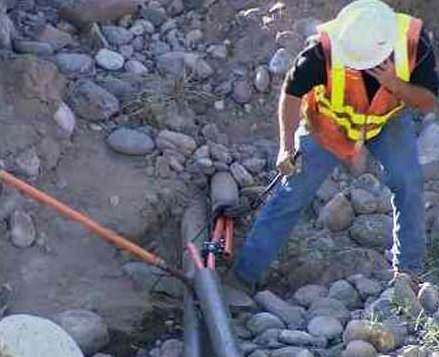What Does It Take to Turn Off the 21st Century? A Saw.
Keep your electronics close, and your backup plan closer.

Some asshole turned off the 21st century in northern Arizona yesterday. The hardest part was probably the hike. The modern world flows to northern Arizona in a cable that runs hundreds of miles through the desert. That cable was cut in an isolated river bed near New River, north of Phoenix. Once the vandals were there, doing damage wasn't that big a challenge. The cable is about as thick through as a man's leg, so the right tool in a backpack was all it took. And there went the 21st century, and maybe a few illusions some of us (**cough**) may have about the extent of our independence.
What went with that cable was most cell phone service (every company but Verizon was down), the Internet (multiple ISPs run through the same pipe), the 911 system, and pretty much any digital communications connection you can imagine. Northern Arizona businesses largely became cash only—including the roadside stops vending gas to cross-country travelers. Trucks lined up waiting for the stations to get back online so they could process company credit cards to fill their tanks. It's not like the drivers could just take out cash—ATMs were down, too.
My wife's pediatric office was able to examine kids and patch them up. But checking on test results, getting reads on x-rays, scheduling appointments with specialists, and electronically sending prescriptions to pharmacies were all out. Old-fashioned landlines worked, but medical facilities are part of the modern world. Thoroughly digitized and electronic, hospitals, labs, and clinics were reduced to sending couriers back and forth.
There's a lot to like about the interconnected, digitized modern world. I wouldn't be telecommuting from a rural area if I didn't have an electronic link to the world beyond. People like me now have the historical luxury of living where we want while doing work that, not so long ago, required an actual presence in a major population center.
But that means we need that electronic link. I thought I was being clever by using a smart phone hotspot as a backup for occasional Internet outages. Unfortunately, for much of its journey, the conduit for my smart phone runs all of two inches from the main Internet connection. Live and learn.
The outage inconvenienced me. Some folks who've grown up in the wired age had a worse time of it. According to CBS 5, "Zak Holland, who works at a computer store at Northern Arizona University, said distraught students were nearly in tears when he said nothing could be done to restore their Internet connection."
Northern Arizona is sparsely settled, which likely explains its weak connection to the modern age. Fiber optic is pricey to lay down per mile, and there's only so much of it that any company can afford to run across the wilderness to serve a scattered population. We get our 3G, but we have to live with the fact that somebody with a grudge, hiking boots, and a spade can take it away.
That's a reality check for those of us who value our independence. I use the Internet to liberate me from places I don't want to live, governed by politicians I don't like, who impose laws I find intrusive. But in the process, I make myself dependent on a six-inch-wide pipe.
So now, to ensure a bit more of that that independence I thought I had, I have to work a bit harder on that backup plan.


Show Comments (77)